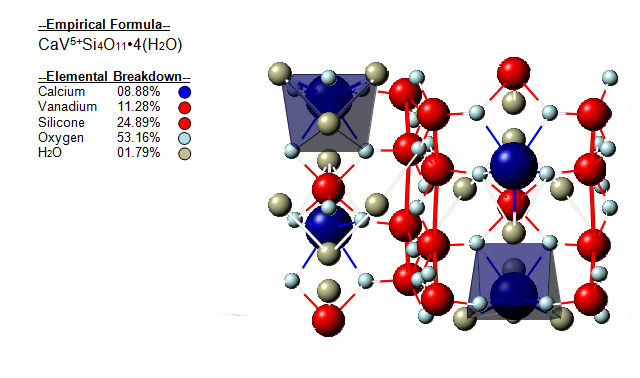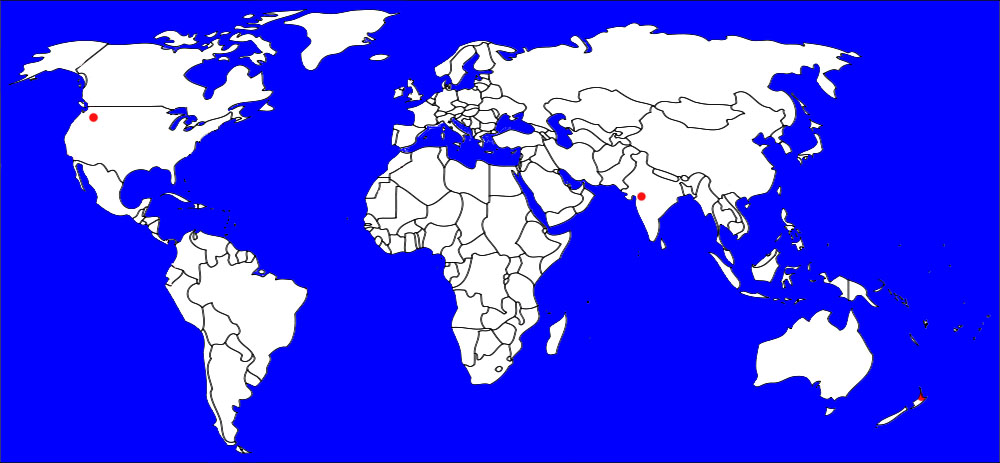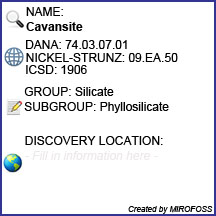

| Mineral Name | Cavansite |
| First Discovered | 1967 |
| Nickel-Strunz Classification | 09.EA.50 |
| Dana Classification | 74.03.07.01 |
| ICSD | 1906 |
| Mineral Group | Silicates - Phyllosilicate with modulated layers |

| Cleavage | Good |
| Colour(s) | Greenish blue, Dark blue |
| Specific Gravity | 2.25 |
| Diaphaneity | Subtranslucent |
| Fracture | Brittle |
| Mohs Hardness | 3.0 to 4.0 |
| Luminescence | Non-fluorescent |
| Luster | Vitreous |
| Streak | Bluish White |
| Habit(s) | Prismatic |
| Radioactivity | Non-radioactive |
| Magnetism | Non-magnetic |

No known health risks have been associated with cavansite. However ingestion of cavansite, as with other naturally occurring minerals, is not recommended.

The following image shows the elemental breakdown of the mineral cavansite along with the mineral crystal structure.


| Crystal System | Orthorhombic |  |
| Class | Dipyramidal | |
| Axial Ratios | a : b : c = 0.7148 : 1 : 0.7019 | |
| Morphology | Spherulitic rosettes | |
| Optical Data Type | Biaxial (+) | |
| Pleochroism (x) | Colourless | |
| Pleochroism (y) | Blue | |
| Pleochroism (z) | Colourless | |
| RL Values | nα = 1.542(2) nβ = 1.544(2) nγ = 1.551(2) |  |
| 2V | Measured: 52° , Calculated: 58° | |
| Max Birefringence | δ = 0.009 (See colour chart at right) | |
| Surface Relief | Low | |
| Dispersion | r < v extreme |

Cavansite cannot be referenced in certain current and historical texts under any other names:
The mineral cavansite can be translated into the following select languages:
| Arabic | Bulgarian | Chinese (Sim) | |||
| Croatian | Czech | Danish | |||
| Dutch | Cavansiet | Esperanto | Estonian | ||
| Finnish | French | German | Cavansit | ||
| Greek | Hebrew | Hungarian | |||
| Italian | Japanese | カビンチャイト | Korean | 카빈차잍으 | |
| Latin | Lithuanian | Norwegian | |||
| Persian | Polish | Cavansyt | Portuguese | ||
| Romanian | Russian | Кавансит | Slovak | ||
| Spanish | Cavansita | Swedish | Tagalog | ||
| Turkish | Ukrainian | Vietnamese |

Cavansite can be found in two (2) places around the world. The map below shows major documented concentrations of cavansite:


 |
The MIROFOSS database offers free printable geological identification tags for personal and non-profit use. These tags can be used to properly identify mineral samples in your collection. -Click here- to download a full size jpeg image for a cavansite identification tag; which can be printed on paper or used with a plastic laser printer. |
 |
What's this? What can I do with it? |

| Chemical Composition | shida, N., Kimata, M., Nishida, N., Hatta, T., Shimizu, M., Akasaka, T. (2009): Polymorphic relation between cavansite and pentagonite: Genetic implications of oxonium ion in cavansite. Journal of Mineralogical and Petrological Sciences, 104, 241-252 |
| Crystallography | Evans, H.T., Jr. (1973): The crystal structures of cavansite and pentagonite. Amer. Mineral., 58, 412-424. |
| History | Staples, L.W., H.T. Evans, Jr., and J.R. Lindsay (1973): Cavansite and pentagonite, new dimorphous calcium vanadium silicate minerals from Oregon. Amer. Mineral., 58, 405-411. |
| Geograpcial Data | Mindat.org. Retrieved on 2012-07-15 |
| Physical Identification | Webmineral.com. Retrieved on 2012-07-15. |
| November 24, 2013 | The last time this page was updated |
| ©2017 MIROFOSS™ Foundation | |
 |